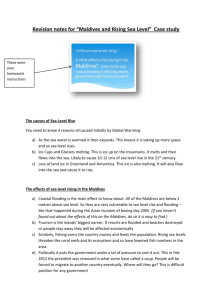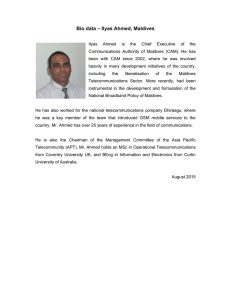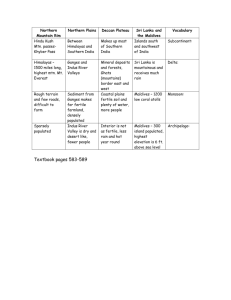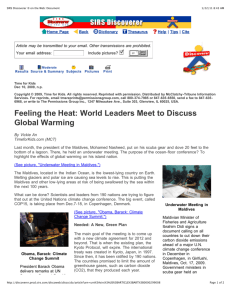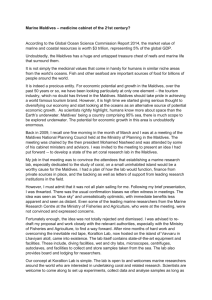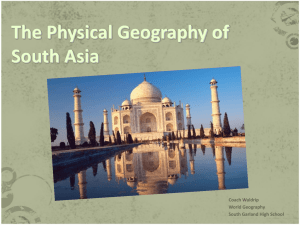Maldives Internet Case Study 8. Conclusions
advertisement
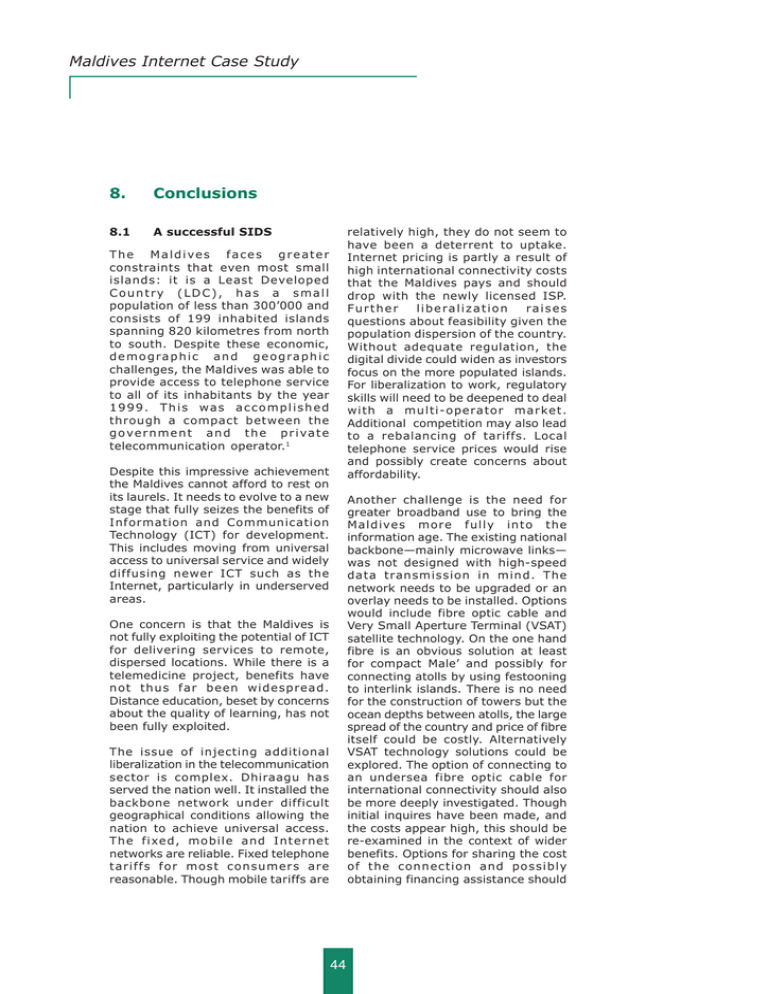
Maldives Internet Case Study 8. Conclusions 8.1 A successful SIDS relatively high, they do not seem to have been a deterrent to uptake. Internet pricing is partly a result of high international connectivity costs that the Maldives pays and should drop with the newly licensed ISP. Further liberalization ra i s e s questions about feasibility given the population dispersion of the country. Without adequate regulation, the digital divide could widen as investors focus on the more populated islands. For liberalization to work, regulatory skills will need to be deepened to deal with a multi-operator market. Additional competition may also lead to a rebalancing of tariffs. Local telephone service prices would rise and possibly create concerns about affordability. The Maldives faces greater constraints that even most small islands: it is a Least Developed Country (LDC), has a small population of less than 300’000 and consists of 199 inhabited islands spanning 820 kilometres from north to south. Despite these economic, d e m o g r a p h i c a n d g e o g ra p h i c challenges, the Maldives was able to provide access to telephone service to all of its inhabitants by the year 1999. This was accomplished through a compact between the g o v e r n m e n t a n d t h e p r i va t e telecommunication operator.1 Despite this impressive achievement the Maldives cannot afford to rest on its laurels. It needs to evolve to a new stage that fully seizes the benefits of Information and Communication Technology (ICT) for development. This includes moving from universal access to universal service and widely diffusing newer ICT such as the Internet, particularly in underserved areas. Another challenge is the need for greater broadband use to bring the Maldives more fully into the information age. The existing national backbone—mainly microwave links— was not designed with high-speed data transmission in mind. The network needs to be upgraded or an overlay needs to be installed. Options would include fibre optic cable and Very Small Aperture Terminal (VSAT) satellite technology. On the one hand fibre is an obvious solution at least for compact Male’ and possibly for connecting atolls by using festooning to interlink islands. There is no need for the construction of towers but the ocean depths between atolls, the large spread of the country and price of fibre itself could be costly. Alternatively VSAT technology solutions could be explored. The option of connecting to an undersea fibre optic cable for international connectivity should also be more deeply investigated. Though initial inquires have been made, and the costs appear high, this should be re-examined in the context of wider benefits. Options for sharing the cost of the connection and possibly obtaining financing assistance should One concern is that the Maldives is not fully exploiting the potential of ICT for delivering services to remote, dispersed locations. While there is a telemedicine project, benefits have not thus far been widespread. Distance education, beset by concerns about the quality of learning, has not been fully exploited. The issue of injecting additional liberalization in the telecommunication sector is complex. Dhiraagu has served the nation well. It installed the backbone network under difficult geographical conditions allowing the nation to achieve universal access. The fixed, mobile and Internet networks are reliable. Fixed telephone tariffs for most consumers are reasonable. Though mobile tariffs are 44 8. Conclusions Figure 8.1: Catching up Telephone subscribers per 100 inhabitants, 1970-2002, world average and Maldives (left) and telephone subscribers per 100 inhabitants, 2002, Maldives and various regional and economic group averages (right) Telephone subscribers (fixed+mobile) per 100 inhabitants World 32.7 22 Maldives 36.9 25 7.3 6.0 4.7 8.5 7 0.2 0.5 0.7 1.2 1970 1975 1980 1985 25.11 Maldives 10.1 2.9 32.4 Middle income 17 13.9 10 36.9 World World / Maldives 12 Telephone subscribers (fixed+mobile) per 100 inhabitants, 2002 22.3 Developing 5.7 3.5 2.4 2 1.5 1990 1995 2001 2002 South Asia LDC 4.6 1.7 Source: ITU World Telecommunication Indicator database. be explored. The government should fully leverage various options and encourage different parties to collaborate and not duplicate infrastructure unless absolutely necessary. 8.2 The ITU launched the Digital Access Index (DAI) in November 2003 as a new way of measuring the ability of nations to provide access to ICT.2 The DAI is based on four factors that have an impact on access: infrastructure (fixed and mobile telephone subscribers), affordability (Internet access costs), knowledge (literacy and school enrolment) and quality (international Internet bandwidth and broadband subscribers). A fifth factor, Internet user penetration, matches the theory of the index with actual usage. The Maldives ranked 92 nd out of 178 countries and was the highestranking LDC and South Asian nation (Figure 8.2, left).3 Its overall score of 0.43 places Maldives in the medium access category. It is useful to compare how Maldives fares in the various factors to see its strengths and weaknesses. In terms of infrastructure it matches the medium access category average while knowledge, quality and usage are above the average. The area it does less well is in affordability (Figure 8.2, right). When compared to the topranking medium access countries, the Maldives needs to raise its level of infrastructure and lower its costs. The country should aim for the goal of moving into the next category, high access (DAI value above 0.49). Assessing the Maldives As noted throughout this report, the Maldives has made exemplary progress in expanding telecommunication access to its citizens. How does the Maldives compare internationally and how ready is it to make use of the benefits from ICT ? In terms of overall infrastructure—fixed and mobile telephones—the Maldives’ rank has risen by 30 positions (from 133 to 93) over the last quarter century. While the country’s telephone density was 22 times less than the world average in 1970, this gap had been reduced to just one and half times by 2002 (Figure 8.1, left). The Maldives has the highest telephone subscribers per capita in South Asia as well as among the LDCs (Figure 8.1, right). It is on target to catch up with middle-income countries in terms of telephone penetration fulfilling one aspect of its aspiration of Vision 2020 to become a middle-income developing nation. 45 Maldives Internet Case Study Figure 8.2: Maldives in the DAI Maldives Digital Access Index values compared to South Asia (left) and Medium access category average (right) Source: ITU. nations. 5 Universal access to telecommunications is also a strong point. The Maldives location can be a plus particularly in attracting ICT businesses that are looking for security and distance from the world’s problems. The ITU has been using a framework developed by the Mosaic Group to gauge the e-readiness of nations.4 That framework has been applied to the Maldives (Box 8.1). Maldives ranks in the mid-range of countries that have been studied. It performs well in terms of overall penetration and absorption of ICT in different sectors of the economy. It does less well in spread of ICT—particularly to the atolls—and organizational infrastructure—with a relatively closed telecommunication market. These are areas that the nation needs to work on to improve its e-readiness ability. The country also has several weaknesses. While the Maldives’ small size and geography can be strengths they are also the source of most of its weaknesses. For example the country’s small population base works against the establishment of a university, constraining higher educational opportunities. This is particularly important since the development of an ICT industry requires advanced skills. Another weakness is the lack of broadband capability in the national backbone. This inhibits the atolls from fully participating in the information society by restricting the functionality of applications such as telemedicine and distance education. The lack of a fibre optic connection for international Internet bandwidth is also a limitation since the quality and pricing of satellite connection is less favourable. It is also useful to carry out a Strengths, Weakness, Opportunities and Threats (SWOT) analysis particularly as they relate to the development of the ICT sector. The Maldives has a number of strengths. Widespread use of English gives it an advantage in the ICT area where so much content and software is in that language. Another positive attribute is the Maldives sense of unity simplifying consensus on national goals and strategies. Good governance is another plus with the public administration scoring well in terms of transparency and efficiency compared to other developing It is important to be realistic about e-opportunities particularly 46 8. Conclusions Box 8.1: State of the Internet in Maldives The International Telecommunication Union (ITU) has been using a framework to analyze the development of the Internet in different nations. Developed by the Mosaic group, the framework consists of values for six different elements that have an impact on Internet take-up.8 Values range from 0 to 4; the higher the value, the better. Pervasiveness measures the overall access rate to the Internet. Maldives is rated common, 3, as the estimated penetration rate is 5.3 per cent of the population (above the one per cent to reach the common level). Dispersion measures the geographical spread of Internet access. All inhabited islands in the Maldives have telephone service. Although Internet access is theoretically available wherever there is a telephone line at a standard nationwide fee, in reality the line would need a PC. On some of the islands, there are only payphones with no PC attached. Public Internet access is available on some 55 islands. Dispersion in the Maldives is rated 2, moderate, with Internet access available from approximately 25 – 33 per cent of inhabited islands. Absorption measures the extent to which different sectors of the economy are using the Internet. Maldives is rated 3, common. Virtually all government agencies have Internet access, as do secondary schools. Large companies and sectors such as tourism and banking have Internet access. The Ministry of Health has a Local Area Network and two hospitals are involved in telemedicine project. Infrastructure measures the extent and speeds of backbone and local access networks. Maldives is rated 2, expanded. Maldives has a well-developed telephone network and has introduced broadband access. However, the predominant method of access to the Internet is still via low-speed, dial-up; there is no national data backbone and international Internet connectivity is via satellite rather than fibre. Organization measures market conditions. Maldives is rated 2, controlled. The Internet market has been a monopoly. A second ISP license was issued in 2003. Sophistication measures how usage ranges from conventional to highly sophisticated. Maldives is rated 2, conventional. The most popular Internet applications appear to be surfing and e-mail The usage of more advanced applications such as media streaming, online banking, e-commerce transactions and government interaction are still developing. The ITU has carried out evaluations for 19 economies since January 2000. One way of comparing economies is to sum the scores of each element. The highest ranked economy thus far is Hong Kong, China with an overall score of 22.5 (out of a possible maximum of 24). The Maldives ranks eighth out of the 19 economies with a score of 15. One benefit of the Mosaic framework is that it highlights which areas a country need to improve to enhance its Internet diffusion. In the case of Maldives, this would be dispersion and organizational, areas where it is below the average of the 19 countries evaluated. In the case of dispersion, there is a need to expand Internet access in the atolls. In the case of organizational, Maldives has recently awarded a second ISP license and it is too soon to see the impact. Figure 8.2: State of Internet in the Maldives Note: The higher the value, the better (0=lowest, 4=highest). Source: ITU. 47 Maldives Internet Case Study new ideas - for an IT village, for the ecological preservation of Hulhumale, for digital mapping of your islands, for a telemedicine link and for a remote sensing centre. These lay down markers for our future endeavours.”7 considering the Maldives’ constraints in terms of small population and limited post-secondary training facilities. However there are certain niche areas worth exploring. One is e-tourism or the application of ICT to tourist services. The country already has a significant tourism industry. Tourism is an information intensive business with the need to provide details to consumers as well as process reservation requests. The Maldives could leverage its large tourism industry to become a leader in e-tourism applications.6 Another opportunity is India given the Maldives historical relations, business ties and geographical proximity. India has the developing world’s largest exportoriented software development industry and hence much expertise in ICT. India has been sharing its expertise with the Maldives and is willing to extend it further. The Indian Prime Minister notes, “O u r cooperation in human resource development spans an entire range from defence to hospitality, from medicine to information technology. We will further widen and intensify this range. We have also discussed some The Maldives is moving in the right direction and has a number of ICT plans and projects. One danger is they could stall due to a lack of commitment or resources. The loss of LDC status is a serious threat since many of the nation’s projects in ICT have been with the assistance of the international development community. This is in some ways tied to another threat, that of marginalization. The Maldives is a small country and at times may seem irrelevant to the global community. This can have a negative impact in terms of raising support and awareness for issues that are important to the Maldives. This all the more reason to embrace ICT as a development enabler particularly since it also ties in with the current emphasis of the international community. In any case, the Maldives has few other alternatives for Table 8.1: Maldives SWOT Strengths, Weaknesses, Opportunities and Threats Strengths Weaknesses Widespread English Lack of tertiary institutions Widespread access to basic telecom Shortage of ICT professionals Current government commitment to ICT ICT regulatory inexperience Good governance Geographic isolation & small size Geographic isolation & small size Lack of fibre-optic bandwidth High literacy Sense of national unity Opportunities Threats Niche in areas such as e-tourism ICT goals become side tracked Leverage on India’s software development expertise Loss of LDC status Telemedicine and distance education Marginalization Brain drain Source: ITU. 48 8. Conclusions diversifying its economy. With few natural resources, limited labour supply and a need to promote an environmentally clean image for the benefit of tourism, agricultural and manufacturing diversification of the economy is not a viable option. 8.3 • • • technologies such as high speed mobile and Wireless Local Area Networks (WLAN or Wi-Fi). This will change as the new ISP has been granted the exclusive use of the 2.4 GHz spectrum for Internet use for the next few years. This is the same frequency that Wi-Fi uses and it is expected that the ISP will quickly rollout services. Dhiraagu is examining the introduction of high-speed mobile service using General Packet Radio Service (GPRS). Given the rapid growth of mobile and the growing number of users that are utilizing their mobiles for data, GPRS looks promising. It could also be an appropriate technology in the atolls for accessing the Internet particularly where fixed lines are limited or slow. The government should encourage these initiatives by facilitating administrative procedures. Recommendations Accelerate enactment of e-laws. The Ministry of Commerce drafted an e-commerce law that legally recognizes electronic transactions. The draft was sent to the Attorney General’s office two years ago but has yet to be approved because of heavy workload and other priorities. Another delay is that all legal documents need to be translated into the national language, Dhivehi. The lack of the necessary laws and online transaction processing is a significant hindrance to the development of e-commerce and e-government applications. Telemedicine. While there are a number of efforts to use ICT to make the health care system more efficient, these are largely limited to the collection and dissemination of information. The Health Master Plan, for example, stipulates the use of information, education and communication to empower people to lead healthy lifestyles. It also emphasizes the need to set up a database to collect essential health indicators and information on ICT-related projects. The Master Plan does not mention the use of telemedicine, despite the fact that it is already used, albeit in a limited way. The geographic particularities of the Maldives suggest that telemedicine should be an attractive application. Even basic telemedicine services, such as the exchange of images, could improve health care services in the islands. Wireless and broadband push. There has been a delay in the adoption of key wireless 49 • Test bed. The Maldives should leverage its unique geographical characteristics and experience from tourism by becoming a development and expertise centre for ICT in these areas. For example, most islands are small. Thus they are ideally suited to wireless LAN technology such as Wi-Fi.9 This would be attractive in resorts for tourists who bring portable computers with them as well as to spread Internet access on inhabited islands for the local community. Another area would be the new Multimedia Messaging Service (MMS) for mobile phones. International roaming already generates considerable revenues and this could be increased given MMS ability to transmit “digital postcards”.10 • Local content development. One of the barriers to getting more people online is that they may not be aware of the benefits or there may not be much content available that interests them. In the Maldives many Internet users surf abroad because there are still not many compelling national Maldives Internet Case Study national accounts, the take-up of ICT in different sectors (i.e., business, government and education) and ICT employment. sites and applications. In order to get additional people using ICT, more locally relevant content will have to be developed. The government can take the lead by developing e-citizen applications. This has particular relevance in the Maldives where distances are great. The ability to complete and process government forms online could save citizens and business transport costs and time spent travelling. The UNDP atoll portal project could also potentially help drive more Maldivians to use the Internet. Another area of content development is tourism. Resorts are in the Maldives and it is logical that content should be developed and hosted in the country. • Statistics. The Maldives has good administrative records for telecommunication services. In addition, the national statistical agency asked about the availability of certain ICT products and services in the 2000 Census (i.e., fixed telephone, PC, television). Policy makers are also monitoring appropriate accessibility indicators such as islands with telephone service and mobile cellular population coverage. There is a need to extend the analysis to other information society areas. For example, it would be useful to know how many households have mobile phones. In particular, there is an urgent requirement for an Internet user survey. This would provide information on the number of Internet users and their characteristics such as location, educational attainment, and gender. This could be carried out by the national statistical agency on a regular basis based on existing international models. In addition, there is a need for information about household expenditure patterns for communication services in order to have a deeper understanding of how affordability affects ICT take-up. There is also a need to measure the ICT sector in the 50 • Distance education. Several development agencies have noted that distance education could have a meaningful impact in the Maldives where “bricks and mortar” educational facilities are limited because of small market size and where two thirds of the population is widely dispersed across two hundred islands. 11 While the Maldives seems like an ideal place to employ online education, neither the facilities in Male’ nor the atolls, are adequately equipped to support it. In addition, there seems to be misgivings about distance education particularly its ability to ensure quality. These issues need to be resolved and a meaningful distance education policy and projects implemented. • Universal access. The Maldives has accomplished universal access to basic telephone service. It now needs to go further. The Telecommunication Policy states: “A majority of the population is deprived of the Internet service due to unavailability of residential telephone lines as well as public Internet access centres, such as cyber cafés, in most of the islands. Hence, priority must be given to expand the telecommunication services and reduce the existing disparity in service provision between Male’ and other islands.” In order to do this, a coordinated and concrete policy is needed. Projects and proposals should be coordinated and existing facilities leveraged to minimize duplication and maximize the resources available. Specifically the relationship between 1) existing private and community Internet cafes, 2) public kiosks as envisaged by the e-government plan and the 3) UNDP atoll ICT project need to be clarified. An 8. Conclusions been very successful. Dhiraagu has provided telephone service to all inhabited islands, a challenging accomplishment considering the geographical layout of the country. Given the unique circumstances of the Maldives—many small relatively sparsely inhabited islands— liberalization may be difficult. Though there is growing evidence that investors can be interested in small markets, the dispersion of population in the Maldives will make it a more difficult proposition. Furthermore, the government has been able to extract concessions from Dhiraagu that will be less likely in a more competitive environment. Thus liberalization should not be pursued as an end in itself, but rather as one way to achieve a modern telecommunication network with a high level of access. Liberalization will require greater resources devoted to regulatory issues such as interconnection and universal service if it is to be successful. A telecommunication act is also a necessary precursor for liberalization to be successful. ideal solution would be to identify one location in each atoll capital (and eventually every island) where affordable high-speed Internet access to government and other Internet services will be available. By combining initiatives it would be possible to achieve a more attractive solution such as high-speed fibre optic, Wi-Fi or VSAT rather than just dial-up access. Pricing and training issues also need to be clarified. • Education. The government needs to enhance universitylevel ICT training. One way is to provide support for ICT activities of the Maldives College of Higher Education. The government should further support the creation of an IT degree. The shortage of IT manpower affects all sectors across the economy, including the government, and the Maldives needs to make sure that it creates its own pool of IT professionals. While it would seem reasonable to rely on foreign universities for specialized training, Maldivians should have the possibility to receive basic IT training in such areas as database management, support, and networking. There is also a need to promote computer literacy and awareness among the public at large. This includes providing training in basic computer skills, particularly for those outside the workforce and academic environment. This could be modelled on the country’s successful adult literacy programme. • Liberalization. There is no doubt that additional liberalization of the telecommunication sector will result in lower pricing for Internet and mobile services. This is the experience of other countries that have introduced competition. However the Maldives is unusual in that the compact between the government and the incumbent telecommunication operator has 51 • Fibre optic. The Maldives reliance on satellite technology for its international Internet connection has drawbacks. The price of Internet connections via fibre tends to be cheaper than satellite, quantity is more abundant and the quality better. The latter is an important point, for if the Maldives is to develop a vibrant software sector— particularly in the area of data hosting—fibre is a must for reliability and speed. Though the cost of an undersea fibre connection will be steep, it should not be measured in purely financial terms. There are wideranging spill over benefits that need to be quantified to form part of the equation. • ICT and the economy. There is widespread belief that ICT can Maldives Internet Case Study pla y a pivotal role in the Maldivian economy. Indeed, with limited resources and a small manufacturing sector, the Maldives has few options for diversifying its economy and ICT seems one of the brightest. This is acknowledged in the various sector and national development plans and the draft ICT strategy which sees employment creation as one of the pillars of ICT mentioning areas such etourism, e-fisheries and software parks. What is now needed is more specificity about the exact impacts, layout and evolution of the ICT sector. This would include an inventory of existing ICT businesses, their output and employment and future evolution. It would also include a detailed description about the types of future ICT businesses that the country would like to establish, employment requirements and linkages to existing and planned training. A macro-economic model showing the relationship between ICT and the economy would be useful for planning. The government should also pick a few strategic ICT businesses it wants to develop and assign resources to attract them. 52 8. Conclusions 1 2 3 4 5 Essentially this could be summarized as the operator meeting specific goals, particularly the completion of a nationwide transmission network in exchange for retaining market exclusivity. Part government ownership of the operator no doubt assisted in ensuring that the operator’s goals were in line with national development priorities. “ITU Digital Access Index: World’s First Global ICT Ranking.” Press Release. 19 November 2003. http://www.itu.int/newsarchive/press_releases/2003/30.html. [Accessed 9 November 2004]. A Bangladesh newspaper commented on the South Asian rankings. See “Bangladesh crawls in the ICT race.” The Daily Star. 24 November 2003. http://www.thedailystar.net/2003/11/24/d31124050248.htm. [Accessed 9 February 2004]. See “The Global Diffusion of the Internet Project” at http://mosaic.unomaha.edu/gdi.html. [Accessed 9 February 2004]. See the World Bank Governance Research Indicator Country Snapshot (GRICS): 1996-2002 at http://info.worldbank.org/governance/kkz2002/sc_chart.asp. [Accessed 9 February 2004]. 6 For more on e-tourism and developing countries see the web page of the UNCTAD Expert Meeting on Electronic Commerce and Tourism held in September 2000: http://www.unctad.org/Templates/meeting.asp?intItemID=1942&lang=1&m=4338. [Accessed 4 February 2004]. 7 8 9 10 11 Statement by Prime Minister Shri Atal Bihari Vajpayee at State Luncheon by President Maumoon Abdul Gayoom of the Republic of Maldives. 23 September 2002. http://meadev.nic.in/speeches/stmt-pm-stateluncheon.htm. [Accessed 9 February 2004]. For definitions of the elements and how values are assigned see “Questionnaire: Global Diffusion of the Internet” at http://som.csudh.edu/fac/lpress/gdiff/quest.htm. [Accessed 9 February 2004]. For example the Mirihi Island Resort, the first to obtain a satellite Internet connection, has installed a W-Fi network noting “It would be very good for the islands in terms of tourism and attracting people to the island.” Alfred Hermida. 31 July 2003. “Paradise island gets wireless web.” BBC News. http://newsvote.bbc.co.uk/mpapps/pagetools/print/news.bbc.co.uk/2/hi/technology/3107027.stm. [Accessed 4 February 2004]. The resort’s website notes the availability of wireless Internet access for those “who need to keep in touch with work or want to send emails to family.” http://www.mirihi.com/internet.html. [Accessed 4 February 2004]. Data are not available on the number of postcards sent from the Maldives but can be inferred from international letter-post items which include postcards. There were 1.5 million international letter-post items sent in 2001 compared to around one million received. Assuming that the difference is accounted for by postcards sent by tourists, this suggests that around 500’000 post cards were sent from the Maldives in 2001. The World Bank calls for distance education to train O level graduates noting that computers are widely available in the atolls. http://lnweb18.worldbank.org/oed/oeddoclib.nsf/DocUNIDViewForJavaSearch/ A2B5EB7F276345B385256C860071A654/$file/Maldives_PPAR.pdf. The Asian Development Bank also had planned for university level distance training as part of an education project. http://www.adb.org/Documents/Profiles/LOAN/28161013.ASP. The following paper also makes the case for promoting distance education at the secondary level: Ali Fawaz Shareet and Kinshuk. 2003. “Distance Education Model for Secondary Schools in Maldives.” Proceedings of the International Conference on Information Technology: Research and Education. 53 Annexes Annex 1: Meeting schedule Date Organization Persons met 28 May Dhiraagu Mr. Mohamed Maumoon, Head of Services Ministry of Communication, Science & Technology Mr. Hussain Shareef, Director General Mr. Mohamed Amir, Director, Telecom Ms. Zulaikha Ibrahim, Telecom Analyst Dhiraagu Mr. Ismail Rasheed, Head of Networks Mr. Umayr Shafeeu, Manager Switching Mr. Ahmed Shaafiu, Marketing Manager Ms. Lina Atkinson, Manager Sales Outlets Ministry of Planning and Development, Statistical Office Ms. Aishath Shahuda, Assistant Director Ministry of Communication, Science & Technology Mr. Midhath Hilmy, Minister Mr. Faig Umar, Assistant Director Ms. Malika Ibrahim, Assistant Director Ministry of Trade and Industries Mr. Fazeel Najeeb, Director International Co-operation Ministry of Education Mr. Ahmed Adeem, Senior System Programmer Ministry of Communication, Science & Technology Mr. Hussain Shareef, Director General Mr. Mohamed Amir, Director, Telecom Enviroweb (Consultants for e-government project) Mr. Michel Boulanger, Consultant in Information Systems Mr. Jesus Garcia, Consultant in Information Systems Asia-Pacific Telecommunity (APT) Mr. Amarendra Narayan, Secretary General Mr. G. Hugh Railton, Deputy Secretary General Dhiraagu Mr. Ismail Waheed, Chief Executive Officer 29 May 1 June 2 June 3 June Opening APT Study Group Meeting College of Higher Education Mr. Hassan Hameed, Rector Ministry of Health Mr. Ahmed Afaal, Assistant Director United Nations Development Programme (UNDP) Mr. Jan Thomas Hiemstra, Deputy Resident Rep. Ms. Nashida Sattar, Programme Officer Focus Computers (2nd ISP) Mr. Sobah Rasheed, Director 55 Maldives Internet Case Study Annex 2: Acronyms ADB Asian Development Bank COL Center for Open Learning FHTS Faculty of Hospitality and Tourism Studies FMC Faculty of Management and Computing ICT Information and Communication Technology ISP Internet Service Provider ITDB Information Technology Development Project (ITDP) Kbps Kilo bits per second LDC Least Developed Countries Mbps Mega bits per second MCHE Maldives College of Higher Education MMS Multimedia Messaging Service MOE Ministry of Education MPND Ministry of Planning and National Development NDP National Development Plan PC Personal computer Rf Maldivian Rufiya. The 2002 annual average rate of Rf 12.85 per one United States dollar is used to make conversions in the report. SAARC South Asian Association for Regional Cooperation SIDS Small Island Developing States SMS Short Messaging Service UNDP United Nations Development Programme VSAT Very Small Aperture Terminal 56 Annexes Annex 3: ICT statistics Note Unit 1995 1996 1997 1998 1999 2000 2001 2002 2003 10x3 10x3 10x6 245 35 4'696 250 36 5'301 254 37 5'982 259 38 6'357 265 40 6'935 270 41 7'348 275 42 7'651 281 43 8'186 285 44 … 11.77 100 11.77 106 11.77 114 11.77 113 11.77 116 11.77 115 12.24 115 12.80 116 … … 13'869 5.67 61.9 89 181 261 15'268 6.12 68.3 … 285 244 17'967 7.07 69.4 … 397 326 19'985 7.72 65.1 … 521 315 22'179 8.37 63.4 … 596 514 24'432 9.05 63 … 629 153 27'242 9.9 62.6 74 723 265 28'651 10.2 63.9 73 773 113 30'056 10.5 … 73 918 44 - 20 … 0.01 1'290 … 0.51 1'606 … 0.62 2'926 35 1.10 7'638 40 2.83 18'894 7'360 40 6.86 41'899 29'625 54 14.91 66'466 53'189 71 23.3 137'118 144'229 142'170 112'936 76'841 81'661 80'169 64'544 20'020 35'947 43'893 51'358 3'601 19'320 32'097 47'407 5'682 5'562 6'900 7'016 6'655 7'212 8'335 10'266 8'330 35'603 53'054 81'580 … … … … … ... ... DEMOGRAPHY, ECONOMY Population 1 Households 2 Gross domestic product 3 Average annual exchange rate per US$ 4 Consumer price index 4 TELEPHONE NETWORK Main telephone lines Main lines per 100 inh. % residential main lines % main lines in urban areas Public payphones Waiting list for main lines % % MOBILE SERVICES GSM mobile subscribers - Cellular prepaid subscribers Coverage of population Cellular subscribers per 100 inh. % TRAFFIC (minutes) Local telephone National trunk telephone Dial-up Internet Fixed-mobile International out. telephone International inc. telephone Mobile 10x3 105'539 107'650 113'813 129'203 10x3 29'645 33'773 54'558 62'537 10x3 ... ... 10'613 10x3 ... ... 3'000 10x3 3'086 3'976 4'384 5'067 10x3 3'612 4'239 5'057 5'903 10x3 1'376 6'927 STAFF Full-time telecommunication - of which female 384 ... 445 ... 399 ... 497 124 550 137 532 131 523 127 519 140 ... ... … 36 52 87.9 57 76.9 45 69.6 46 55.9 … 55.7 ... 52.3 90 46.4 … ... 1'720 30 0.25 - 1'720 30 0.25 1'000 300 7.5 6.75 1'720 30 0.25 1'000 300 7.5 6.75 1'720 30 0.25 1'000 300 7.5 6.75 1'720 30 0.25 1'000 300 7.5 6.75 1'720 30 0.25 1'000 300 7.5 6.75 1'720 30 0.25 500 150 6.75 5.70 1'720 30 0.25 500 150 6.75 5.70 1'720 30 0.25 500 150 6.75 5.40 10x6 10x6 220 - 316 … 399 … 460 29 529 30 624 100 720 201 835 360 … … 10x6 110 176 173 131 100 135 88 102 … 12'000 113 13'800 280 15'800 450 18'100 750 20'700 1'300 23'204 2'094 26'010 3'500 29'100 5'800 ... ... 3'000 - 4'000 575 - 5'000 ... 800 0.64 6'000 763 1'500 0.64 7'500 939 3'000 2 10'000 1'060 6'000 3 15'000 1'100 10'000 5 20'000 1'067 190 15'000 9 ... 1'147 490 ... ... QUALITY OF SERVICE % Telephone faults cleared by next day % Faults per 100 main lines per year % TARIFFS Telephone connection Telephone monthly subscription Local call (per minute) Cellular connection Cellular monthly subscription Cellular - 3-min. local call (peak) Cellular - 3-min. local call (economy) REVENUE Total telecom services - Mobile communication CAPITAL EXPENDITURE Annual telecom investment BROADCASTING Television equipped households 5 Home satellite antennas 5 INFORMATION TECHNOLOGY Personal computers Internet subscribers 6 - DSL Internet subscribers Estimated Internet users International Internet Bandwidth (Mbps) Note: (1) Source: Ministry of Planning and National Development (MPND) mid-year estimates. (2) Source: MPND (1995, 2000); ITU estimates (other years). (3) At market prices. Source: MPND. (4) Source: IMF. (5) 2000 = Census. Other years, ITU estimate. 1995-96: Dhiraagu, 2000: Census, other years: ITU estimate. (6) Not including “pay as you go” users. Source: Dhiraagu, Ministry of Communications, Science and Technology. 57 Maldives Internet Case Study Annex 4: Bibliography Asian Development Bank. November 2001. Report and Recommendation of the President to the Board of Directors on a proposed loan to the Republic of Maldives for the Information Technology Development Project. http://www.adb.org/Documents/RRPS/MLD/rrp_34276.pdf. Ministry of Communication, Science and Technology. 2003. e-Maldives: The Republic of Maldives National Information and Communications Technology Policy. Draft. Ministry of Communication, Science and Technology. August 2001. Maldives Telecommunication Policy 2001-2005. http://www.mcst.gov.mv/Downloads/Documents/Telecom%20Policy-Public.pdf. Ministry of Communication, Science and Technology. April 2001. Republic of Maldives Science and Technology Master Plan. http://www.mcst.gov.mv/Documents/mplan.htm. Ministry of Education. March 2001. Information Technology and Education, Policy and Strategies. Draft. Ministry of Planning and National Development. 2002. Analytical Report. Population and Housing Census of the Maldives 2000. Ministry of Planning and National Development. 2002. Sixth National Development Plan 2001-2005. http://www.presidencymaldives.gov.mv/v3/pages/body.phtml?ID=12&Table=Head2&PTID=4. Ministry of Planning and National Development. Statistical Yearbook of Maldives 2002. Republic of Maldives. Vision 2020. http://www.presidencymaldives.gov.mv/v3/pages/body.phtml?ID=10&Table=Head2&PTID=4. 58

